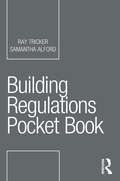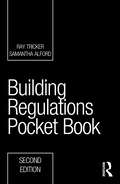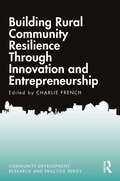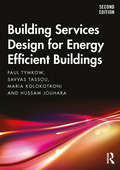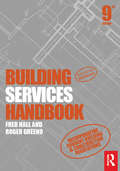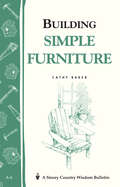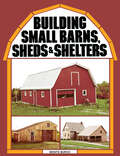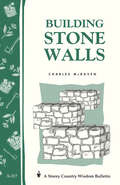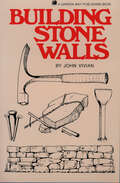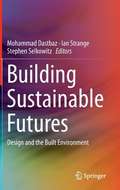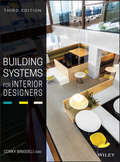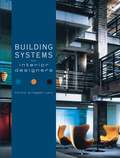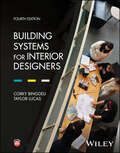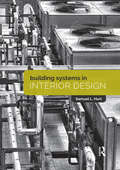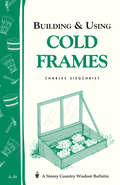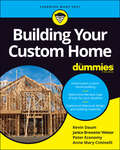- Table View
- List View
Building Regulations Pocket Book (Routledge Pocket Books)
by Ray Tricker Samantha AlfordThis handy guide provides you with all the information you need to comply with the UK Building Regulations and Approved Documents. On site, in the van, in the office, wherever you are, this is the book you’ll refer to time and time again to double check the regulations on your current job. The Building Regulations Pocket Book is the must have reliable and portable guide to compliance with the Building Regulations. Part 1 provides an overview of the Building Act Part 2 offers a handy guide to the dos and don’ts of gaining the Local Council’s approval for Planning Permission and Building Regulations Approval Part 3 presents an overview of the requirements of the Approved Documents associated with the Building Regulations Part 4 is an easy to read explanation of the essential requirements of the Building Regulations that any architect, builder or DIYer needs to know to keep their work safe and compliant on both domestic or non-domestic jobs This book is essential reading for all building contractors and sub-contractors, site engineers, building engineers, building control officers, building surveyors, architects, construction site managers and DIYers. Homeowners will also find it useful to understand what they are responsible for when they have work done on their home (ignorance of the regulations is no defence when it comes to compliance!).
Building Regulations Pocket Book (Routledge Pocket Books)
by Ray Tricker Samantha AlfordThe new edition of the Building Regulations Pocket Book has been fully updated with recent changes to the UK Building Regulations and Planning Law. This handy guide provides you with all the information you need to comply with the UK Building Regulations and Approved Documents. On site, in the van, in the office – wherever you are – this is the book you’ll refer to time and time again to check the regulations on your current job. Part 1 provides an overview of the Building Act. Part 2 offers a handy guide to the dos and don’ts of gaining the Local Council’s approval for Planning Permission and Building Regulations Approval. Part 3 presents an overview of the requirements of the Approved Documents associated with the Building Regulations. Part 4 is an easy-to-read explanation of the essential requirements of the Building Regulations that any architect, builder or DIYer needs to know to keep their work safe and compliant on both domestic and non-domestic jobs. Key new updates to this second edition include, but are not limited to: changes to the fire regulations as a result of the Hackitt Review, updates to Approved Document F and L, new Approved Documents covering Overheating (AD-O) and Infrastructure for the charging of electric vehicles (AD-S), amendments to and the reinstatement of the Manual to the Building Regulations. This book is essential reading for all building contractors and sub-contractors, site engineers, building engineers, building control officers, building surveyors, architects, construction site managers as well as DIYers and those who are supervising work in their own home.
Building Regulations Pocket Book (Routledge Pocket Books)
by Ray Tricker Samantha AlfordThe new edition of the Building Regulations Pocket Book has been fully updated with recent changes to the UK Building Regulations and Planning Law. This handy guide provides you with all the information you need to comply with the UK Building Regulations and Approved Documents. On site, in the van, in the office – wherever you are – this is the book you’ll refer to time and time again to check the regulations on your current job. Part 1 provides an overview of the Building Act. Part 2 offers a handy guide to the dos and don’ts of gaining the Local Council’s approval for Planning Permission and Building Regulations Approval. Part 3 presents an overview of the requirements of the Approved Documents associated with the Building Regulations. Part 4 is an easy-to-read explanation of the essential requirements of the Building Regulations that any architect, builder or DIYer needs to know to keep their work safe and compliant on both domestic and non-domestic jobs. Key new updates to this second edition include, but are not limited to: changes to the fire regulations as a result of the Hackitt Review, updates to Approved Document F and L, new Approved Documents covering Overheating (AD-O) and Infrastructure for the charging of electric vehicles (AD-S), amendments to and the reinstatement of the Manual to the Building Regulations. This book is essential reading for all building contractors and sub-contractors, site engineers, building engineers, building control officers, building surveyors, architects, construction site managers as well as DIYers and those who are supervising work in their own home.
Building Rural Community Resilience Through Innovation and Entrepreneurship (ISSN)
by Charlie FrenchDrawing from empirical analyses, case studies, and a synthesis of best practices, this book explores how innovation manifests itself in rural places and how it contributes to entrepreneurial development and resilience. Innovation in rural places may come about as a result of new forms of collaboration; policies that leverage rural assets and address critical service or product gaps; novel strategies for accessing financial capital; infusion of arts into aspects of community life; and cultivation of networks that bridge entrepreneurs, organizations, and institutions. The chapters illustrate how a number of innovation-related characteristics relate to economic vibrancy in rural places such as a strong connection to the arts, adaptive and sustainable use of natural resources, value-chain integrated food systems, robust bridging social capital networks, creative leveraging of technology, and presence of innovation-focused entrepreneurs. Through exploration of these and other topics, this book will provide insights and best practices for rural community and economic development scholars and practitioners seeking to strengthen the rural innovation ecosystem.
Building Rural Community Resilience Through Innovation and Entrepreneurship (ISSN)
by Charlie FrenchDrawing from empirical analyses, case studies, and a synthesis of best practices, this book explores how innovation manifests itself in rural places and how it contributes to entrepreneurial development and resilience. Innovation in rural places may come about as a result of new forms of collaboration; policies that leverage rural assets and address critical service or product gaps; novel strategies for accessing financial capital; infusion of arts into aspects of community life; and cultivation of networks that bridge entrepreneurs, organizations, and institutions. The chapters illustrate how a number of innovation-related characteristics relate to economic vibrancy in rural places such as a strong connection to the arts, adaptive and sustainable use of natural resources, value-chain integrated food systems, robust bridging social capital networks, creative leveraging of technology, and presence of innovation-focused entrepreneurs. Through exploration of these and other topics, this book will provide insights and best practices for rural community and economic development scholars and practitioners seeking to strengthen the rural innovation ecosystem.
Building Services Design for Energy Efficient Buildings
by Paul Tymkow Savvas Tassou Maria Kolokotroni Hussam JouharaThe role and influence of building services engineers are undergoing rapid change and are pivotal to achieving low-carbon buildings. However, textbooks in the field have tended to remain fairly traditional with a detailed focus on the technicalities of heating, ventilation and air-conditioning (HVAC) systems, often with little wider context. This book addresses that need by embracing a contemporary understanding of the challenge to address climate change, together with practical approaches to energy efficiency and carbon mitigation for mechanical and electrical systems, in a concise manner. The essential conceptual design issues for planning the principal building services systems that influence energy efficiency are examined in detail. These are HVAC and electrical systems. In addition, the following issues are addressed: background issues on climate change, whole-life performance and design collaboration generic strategies for energy efficient, low-carbon design health & wellbeing and post-occupancy evaluation building ventilation air-conditioning and HVAC system selection thermal energy generation and distribution systems low-energy approaches for thermal control electrical systems, data collection, controls and monitoring building thermal load assessment building electric power load assessment space planning and design integration with other disciplines. In order to deliver buildings that help to mitigate climate change impacts, a new perspective is required for building services engineers, from the initial conceptual design and throughout the design collaboration with other disciplines. This book provides a contemporary introduction and guide to this new approach, for students and practitioners alike.
Building Services Design for Energy Efficient Buildings
by Paul Tymkow Savvas Tassou Maria Kolokotroni Hussam JouharaThe role and influence of building services engineers are undergoing rapid change and are pivotal to achieving low-carbon buildings. However, textbooks in the field have tended to remain fairly traditional with a detailed focus on the technicalities of heating, ventilation and air-conditioning (HVAC) systems, often with little wider context. This book addresses that need by embracing a contemporary understanding of the challenge to address climate change, together with practical approaches to energy efficiency and carbon mitigation for mechanical and electrical systems, in a concise manner. The essential conceptual design issues for planning the principal building services systems that influence energy efficiency are examined in detail. These are HVAC and electrical systems. In addition, the following issues are addressed: background issues on climate change, whole-life performance and design collaboration generic strategies for energy efficient, low-carbon design health & wellbeing and post-occupancy evaluation building ventilation air-conditioning and HVAC system selection thermal energy generation and distribution systems low-energy approaches for thermal control electrical systems, data collection, controls and monitoring building thermal load assessment building electric power load assessment space planning and design integration with other disciplines. In order to deliver buildings that help to mitigate climate change impacts, a new perspective is required for building services engineers, from the initial conceptual design and throughout the design collaboration with other disciplines. This book provides a contemporary introduction and guide to this new approach, for students and practitioners alike.
Building Services Handbook
by Fred Hall Roger GreenoThe ninth edition of Hall and Greeno's leading textbook has been reviewed and updated in relation to the latest building and water regulations, new technology, and new legislation. For this edition, new updates includes: the reappraisal of CO2 emissions targets, updates to sections on ventilation, fuel, A/C, refrigeration, water supply, electricity and power supply, sprinkler systems, and much more. Building Services Handbook summarises the application of all common elements of building services practice, technique and procedure, to provide an essential information resource for students as well as practitioners working in building services, building management and the facilities administration and maintenance sectors of the construction industry. Information is presented in the highly illustrated and accessible style of the best-selling companion title Building Construction Handbook. THE comprehensive reference for all construction and building services students, Building Services Handbook is ideal for a wide range of courses including NVQ and BTEC National through Higher National Certificate and Diploma to Foundation and three-year Degree level. The clear illustrations and complementary references to industry Standards combine essential guidance with a resource base for further reading and development of specific topics.
Building Services Handbook: Incorporating Current Building And Construction Regulations - Xplana Bundle
by Fred Hall Roger GreenoThe ninth edition of Hall and Greeno's leading textbook has been reviewed and updated in relation to the latest building and water regulations, new technology, and new legislation. For this edition, new updates includes: the reappraisal of CO2 emissions targets, updates to sections on ventilation, fuel, A/C, refrigeration, water supply, electricity and power supply, sprinkler systems, and much more. Building Services Handbook summarises the application of all common elements of building services practice, technique and procedure, to provide an essential information resource for students as well as practitioners working in building services, building management and the facilities administration and maintenance sectors of the construction industry. Information is presented in the highly illustrated and accessible style of the best-selling companion title Building Construction Handbook. THE comprehensive reference for all construction and building services students, Building Services Handbook is ideal for a wide range of courses including NVQ and BTEC National through Higher National Certificate and Diploma to Foundation and three-year Degree level. The clear illustrations and complementary references to industry Standards combine essential guidance with a resource base for further reading and development of specific topics.
Building Simple Furniture: Storey Country Wisdom Bulletin A-06 (Storey Country Wisdom Bulletin)
by Cathy BakerEASY-TO-BUILD PROJECTS FOR THE WEEKEND WOODWORKER!Look over the variety of simple wood-working projects in the bulletin and you’ll quickly find something that deserves a place in your home. A small table for the hallway, perhaps, or an Adirondack chair or picnic set for the deck or garden? The good news is that you don’t need to be a master carpenter with a basement full of power tools to craft these handsome and practical items. With a few simple hand tools and Cathy Baker’s step-by-step instructions and easy-to-follow illustrations and diagrams, you can build sturdy, durable, beautiful wooden furniture that you and your family will enjoy for years to come. Projects include:· Wall shelf· Small bench· Picnic table and benches· Adirondack chair· Pump lamp· Step stool· Storage box· Side table
Building Small Barns, Sheds & Shelters
by Monte BurchBuild your own outbuildings and enjoy the space to do more of what you love. From simple toolsheds and animal shelters to smokehouses and low-cost barns, Monte Burch guides you through everything you need to know to make your small building projects a reality. Detailed blueprints, easy-to-follow instructions, and expert advice are suited to even the first-time builder. Discover how easy it is to create your own customized spaces that will allow your passions to grow.
Building Stone Walls: Storey's Country Wisdom Bulletin A-217 (Storey Country Wisdom Bulletin)
by Charles McRavenSince 1973, Storey's Country Wisdom Bulletins have offered practical, hands-on instructions designed to help readers master dozens of country living skills quickly and easily. There are now more than 170 titles in this series, and their remarkable popularity reflects the common desire of country and city dwellers alike to cultivate personal independence in everyday life.
Building Stone Walls
by John VivianRustic and charming or stately and proud, a well-built stone wall can add personality and beauty to your property. John Vivian&’s lively approach and step-by-step instructions encourage you to transform a pile of rocks into an enduring landscape feature with gates, retaining walls, or stiles to suit your needs. Whatever unique challenges come with your site — poor drainage, sloping ground, or low-quality rubble material — Vivian offers innovative designs and reproducible methods to help you build a beautiful, long-lasting wall.
Building Sustainable Futures: Design and the Built Environment
by Mohammad Dastbaz Jon Price Ian Strange Stephen SelkowitzThis book presents state-of-the-art research and case studies on new approaches to the design, construction and planning of our cities. Emphasis is placed on the role of alternative and renewable energy in the development of urban infrastructures that enable sustainable futures. Reflecting the multi-faceted efforts required to successfully meet sustainability challenges, this book is a collaboration between practitioners and academics across a broad spectrum of specializations. Compelling research findings are explained in the context of practical implementation, enhanced by case studies from industry leaders in order to create a pragmatic reference across policy areas where environmentally aware decision making is required.
Building Sustainable Futures: Design and the Built Environment (PDF)
by Mohammad Dastbaz Jon Price Ian Strange Stephen SelkowitzThis book presents state-of-the-art research and case studies on new approaches to the design, construction and planning of our cities. Emphasis is placed on the role of alternative and renewable energy in the development of urban infrastructures that enable sustainable futures. Reflecting the multi-faceted efforts required to successfully meet sustainability challenges, this book is a collaboration between practitioners and academics across a broad spectrum of specializations. Compelling research findings are explained in the context of practical implementation, enhanced by case studies from industry leaders in order to create a pragmatic reference across policy areas where environmentally aware decision making is required.
Building Systems for Interior Designers
by Corky BinggeliThe ultimate interior designer's guide to building systems and safety Building Systems for Interior Designers, Third Edition is the single-source technical reference that every designer needs, and an ideal solution for NCIDQ exam preparation. Now in its third edition, this invaluable guide has been updated to better address the special concerns of the interior designer within the context of the entire design team. New coverage includes the latest information on sustainable design and energy conservation, expanded coverage of security and building control systems, and a new and expanded art program with over 250 new illustrations. Covering systems from HVAC to water to waste to lighting, this book explains technical building systems and engineering issues in a clear and accessible way to help interior designers communicate more effectively with architects, engineers, and contractors. Professional interior design is about much more than aesthetics and decorating, and technical knowledge is critical. Before the space is planned, the designer must consider the mechanical and electrical equipment, structural system, and building components, and how they impact the space. This book shows you how to evaluate these complex factors, and how each affects your work throughout the building. Consider how site conditions and structural systems affect interior design Design functionally for human health and safety Factor water, electrical, and thermal systems into your design plans Examine the ways in which lighting and acoustics affect the space The comfort, safety, and ultimate success of a project depend upon your knowledge of building system and your coordination with architects and engineers. Building Systems for Interior Designers, Third Edition provides the comprehensive yet focused information you need to excel at what you do best.
Building Systems for Interior Designers
by Corky BinggeliThe ultimate interior designer's guide to building systems and safety Building Systems for Interior Designers, Third Edition is the single-source technical reference that every designer needs, and an ideal solution for NCIDQ exam preparation. Now in its third edition, this invaluable guide has been updated to better address the special concerns of the interior designer within the context of the entire design team. New coverage includes the latest information on sustainable design and energy conservation, expanded coverage of security and building control systems, and a new and expanded art program with over 250 new illustrations. Covering systems from HVAC to water to waste to lighting, this book explains technical building systems and engineering issues in a clear and accessible way to help interior designers communicate more effectively with architects, engineers, and contractors. Professional interior design is about much more than aesthetics and decorating, and technical knowledge is critical. Before the space is planned, the designer must consider the mechanical and electrical equipment, structural system, and building components, and how they impact the space. This book shows you how to evaluate these complex factors, and how each affects your work throughout the building. Consider how site conditions and structural systems affect interior design Design functionally for human health and safety Factor water, electrical, and thermal systems into your design plans Examine the ways in which lighting and acoustics affect the space The comfort, safety, and ultimate success of a project depend upon your knowledge of building system and your coordination with architects and engineers. Building Systems for Interior Designers, Third Edition provides the comprehensive yet focused information you need to excel at what you do best.
Building Systems for Interior Designers
by Corky BinggeliThe first desk reference on technical building systems for interior designers Building Systems for Interior Designers is the first book to explain technical building systems and engineering issues in a clear and accessible way to interior designers. The technical knowledge and vocabulary presented here allow interior designers to communicate more effectively with architects, engineers, and contractors while collaborating on projects, leading to more accurate solutions for problems related to a broad range of other building considerations with an impact on interior design. Information on sustainable design is integrated throughout the book, making it a relevant tool for current and emerging trends in building design. Written in a straightforward, nontechnical style that maintains depth and accuracy, this book is the first complete text applicable to interior design courses and provides thorough preparation for the NCIDQ exam. Engaging, clear illustrations support the text, which is accessible to those without a math or physics background. Topics covered include: Heating and air conditioning systems Environmental issues Water and waste Thermal comfort HVAC systems Electricity Lighting Security and communications systems Fire safety Transportation systems With numerous case examples illustrating how interior designers apply this material in the real world, Building Systems for Interior Designers is a valuable book for students, as well as a practical desktop reference for professionals. Content from this book is available as an online continuing professional education course at http://www.wiley.com/WileyCDA/Section/id-320255.html#fire_safety. WileyCPE courses are available on demand, 24 hours a day, and are approved by the American Institute of Architects.
Building Systems for Interior Designers
by Corky Binggeli Taylor LucasBUILDING SYSTEMS FOR INTERIOR DESIGNERS Make design decisions informed by technical and structural knowledge with this essential guide Professional interior design demands more than simply an understanding of aesthetic and artistic considerations; it also requires a detailed understanding of building systems and their interactions. Design decisions must account for mechanical and electrical equipment, building components, and structural elements, all of which can potentially shape a designer’s work. Building Systems for Interior Designers has long stood as the key to understanding and evaluating these elements, particularly key building systems like HVAC and plumbing, and their impacts on interior design. This Fourth Edition is fully updated to fit the needs of the CIDA certified interior design program and the NCIDQ exam. The fourth edition of Building Systems for Interior Designers also includes: Updated information on sustainable and energy-efficient design Detailed coverage of topics including security concerns, fire safety, and designing secure spaces Classroom supplements including sample construction documents, chapter specific discussion questions, and more Building Systems for Interior Designers is ideal for students in interior design courses and new professionals studying for NCIDQ exams.
Building Systems for Interior Designers
by Corky Binggeli Taylor LucasBUILDING SYSTEMS FOR INTERIOR DESIGNERS Make design decisions informed by technical and structural knowledge with this essential guide Professional interior design demands more than simply an understanding of aesthetic and artistic considerations; it also requires a detailed understanding of building systems and their interactions. Design decisions must account for mechanical and electrical equipment, building components, and structural elements, all of which can potentially shape a designer’s work. Building Systems for Interior Designers has long stood as the key to understanding and evaluating these elements, particularly key building systems like HVAC and plumbing, and their impacts on interior design. This Fourth Edition is fully updated to fit the needs of the CIDA certified interior design program and the NCIDQ exam. The fourth edition of Building Systems for Interior Designers also includes: Updated information on sustainable and energy-efficient design Detailed coverage of topics including security concerns, fire safety, and designing secure spaces Classroom supplements including sample construction documents, chapter specific discussion questions, and more Building Systems for Interior Designers is ideal for students in interior design courses and new professionals studying for NCIDQ exams.
Building Systems in Interior Design
by Sam HurtBuilding Systems in Interior Design takes an entirely new approach to teaching this essential topic for Architects, Designers and Building Engineers. Written to prepare students for the real world and packed with practical examples, the book will foster an understanding of specific issues that are critical to those features of technical systems that most directly affect design. The book stresses the ever-present nature of these systems: they are everywhere, all the time. Taking a design oriented view, it outlines what can and cannot be done, and provides the student with the know-how and confidence to defend and promote their design intent when working with other industry professionals. Covering lighting, HVAC, plumbing and much more, the book is packed with key features to aid learning including: Numerous illustrations, plans and photographs Key terms defined in an extensive glossary Chapter introductions that identify key concepts and chapter summaries to re-visit those key concepts Professional design tips And a detailed bibliography and web links This book is not only a core text for interior design, building systems engineering and architecture students but will become an essential working reference through their careers.
Building Systems in Interior Design
by Sam HurtBuilding Systems in Interior Design takes an entirely new approach to teaching this essential topic for Architects, Designers and Building Engineers. Written to prepare students for the real world and packed with practical examples, the book will foster an understanding of specific issues that are critical to those features of technical systems that most directly affect design. The book stresses the ever-present nature of these systems: they are everywhere, all the time. Taking a design oriented view, it outlines what can and cannot be done, and provides the student with the know-how and confidence to defend and promote their design intent when working with other industry professionals. Covering lighting, HVAC, plumbing and much more, the book is packed with key features to aid learning including: Numerous illustrations, plans and photographs Key terms defined in an extensive glossary Chapter introductions that identify key concepts and chapter summaries to re-visit those key concepts Professional design tips And a detailed bibliography and web links This book is not only a core text for interior design, building systems engineering and architecture students but will become an essential working reference through their careers.
Building & Using Cold Frames: Storey Country Wisdom Bulletin A-39 (Storey Country Wisdom Bulletin)
by Charles SiegchristSince 1973, Storey's Country Wisdom Bulletins have offered practical, hands-on instructions designed to help readers master dozens of country living skills quickly and easily. There are now more than 170 titles in this series, and their remarkable popularity reflects the common desire of country and city dwellers alike to cultivate personal independence in everyday life.
Building Your Custom Home For Dummies
by Kevin Daum Janice Brewster Peter Economy Anne Mary CiminelliBuild a place you’ll love to come home to Why settle for a house that looks like every other one in the neighborhood? With Building Your Custom Home For Dummies on your desk (right alongside those inspiring architecture magazines), you can design and build the home of your dreams. From brainstorming must-have features to hanging a wreath on the front door, this book walks you through what you need to know from start to finish. Get savvy on purchasing property, securing financing, and raising the walls that will become the setting for life’s next chapter. If you can imagine it, you can build it! Inside… Locate your ideal building site Hire an architecture and contracting team you can trust Finance smoothly and manage your construction budget Discover new green building techniques Oversee construction from A to Z Furnish, landscape, and maintain your property
Building Your Custom Home For Dummies
by Kevin Daum Janice Brewster Peter Economy Anne Mary CiminelliBuild a place you’ll love to come home to Why settle for a house that looks like every other one in the neighborhood? With Building Your Custom Home For Dummies on your desk (right alongside those inspiring architecture magazines), you can design and build the home of your dreams. From brainstorming must-have features to hanging a wreath on the front door, this book walks you through what you need to know from start to finish. Get savvy on purchasing property, securing financing, and raising the walls that will become the setting for life’s next chapter. If you can imagine it, you can build it! Inside… Locate your ideal building site Hire an architecture and contracting team you can trust Finance smoothly and manage your construction budget Discover new green building techniques Oversee construction from A to Z Furnish, landscape, and maintain your property
